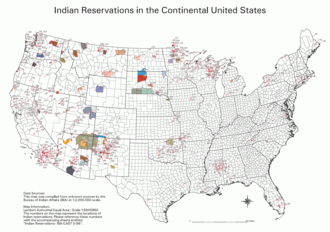Native American reservations
| Native American reservations | |
|---|---|
|
Also known as: Domestic Dependent Nation |
|
 |
|
| Category | Autonomous administrative divisions |
| Location | United States of America |
| Created | 1658 (Powhatan Tribes) |
| Number | 326 (map includes the 310 as of May 1996) |
| Populations | 123 (several) - 173,667 (Navajo Nation) |
| Areas | ranging from the 1.32-acre (0.534 hectares) Pit River Tribe's cemetery in California to the 16 million-acre (64 750 square kilometers) Navajo Nation Reservation located in Arizona, New Mexico, and Utah |
An Indian reservation is a legal designation for an area of land managed by a Native American tribe under the US Bureau of Indian Affairs, rather than the state governments of the United States in which they are physically located. Each of the 326Indian reservations in the United States are associated with a particular Nation. Not all of the country's 567recognized tribes have a reservation—some tribes have more than one reservation, some share reservations, while others have none. In addition, because of past land allotments, leading to some sales to non-Native Americans, some reservations are severely fragmented, with each piece of tribal, individual, and privately held land being a separate enclave. This jumble of private and public real estate creates significant administrative, political, and legal difficulties.
The collective geographical area of all reservations is 56,200,000 acres (22,700,000 ha; 87,800 sq mi; 227,000 km2), approximately the size of Idaho. While most reservations are small compared to US states, there are 12 Indian reservations larger than the state of Rhode Island. The largest reservation, the Navajo Nation Reservation, is similar in size to West Virginia. Reservations are unevenly distributed throughout the country; the majority are west of the Mississippi River and occupy lands that were first reserved by treaty or 'granted' from the public domain.
...
Wikipedia
